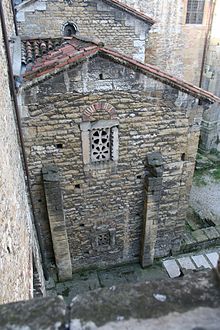Cámara Santa, Oviedo
| Holy chamber of Oviedo Cámara Santa de Oviedo (Spanish) |
|
|---|---|
 |
|
| Basic information | |
| Location |
|
| Geographic coordinates | 43°21′44″N 5°50′34.37″W / 43.36222°N 5.8428806°WCoordinates: 43°21′44″N 5°50′34.37″W / 43.36222°N 5.8428806°W |
| Affiliation | Roman Catholic |
| Province | Asturias |
| Ecclesiastical or organizational status | Chapel |
| Heritage designation | World Heritage Site |
| Website | Official Website |
| Architectural description | |
| Architectural type | Church |
| Architectural style | Pre-Romanesque |
| Completed | 9th century |
| Type | Cultural |
| Criteria | ii, iv, vi |
| Designated | 1985 (9th session) |
| Parent listing | Monuments of Oviedo and the Kingdom of the Asturias |
| Reference no. | 312 |
| Extensions | 1998 |
| State Party | Spain |
| Region | Europe and North America |
The Holy chamber of Oviedo (Spanish: Cámara Santa de Oviedo, also known as the chapel of St. Michael) is a Roman Catholic pre-Romanesque church in Oviedo, Spain, built next to pre-romanesque Tower of San Miguel of the city's cathedral. Nowadays, the church occupies the angle between the south arm of the cathedral transept and a side of the cloister.
It was built during the 9th century as a palace chapel for King Alfonso II of Asturias and the church of San Salvador of Oviedo (both demolished in the 14th century to build the present Gothic Cathedral of Oviedo). Apart from acting as royal chapel, the Holy Chamber was built to house the jewels and relics of the cathedral of San Salvador in Oviedo, a function it continues to have 1200 years later. Some of these jewels were donated by the Kings Alfonso II and Alfonso III, and represent extraordinary gold artifacts of Asturian Pre-Romanesque, brought from Toledo after the fall of the Visigothic kingdom.
Consequently, the cathedral of Oviedo was also called Sancta Ovetensis; owing to quantity and quality of relics contained in the Cámara Santa (English: Holy Chamber). The Holy Chamber remains as the only sample of the early medieval complex. It was built as a relics' room to keep the different treasures associated with the Kingdom of Asturias (Cross of the Angels, Victory Cross, Agate box, Arca Santa and Sudarium of Oviedo), brought from Jerusalem to Africa, and after several translations was finally deposited at Oviedo by Alfonso II of Asturias.
It was declared a World Heritage Site by UNESCO in December 1998.
...
Wikipedia
